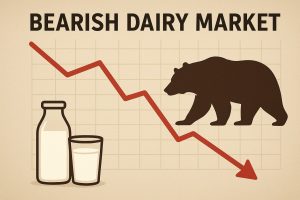
“We estimate that milk supply currently exceeds demand by at least 10%.”
We concur with this assessment. Here is our back-of-the-envelope math: Before the Coronavirus, we estimate USA cheese sales in the following segments: 46% retail, 16% pizza, and 38% to food service and other channels for a total of 100%.
In the coming weeks, we believe retail sales will only grow by about 20% YoY, and pizza sales may be up slightly, say 2.0%. Other food service sales have collapsed and are down 80%, meaning cheese consumption in the USA will shrink by an estimated total of about 21% during Apr. This is equivalent to 214 million fewer lbs of cheese needed, 2.1 billion lbs less milk or about 11% of all milk produced during the month.
“Pay producers $3 per hundredweight on 90% of their production if they cut production by 10% from March 2020 baseline. Program runs for six months – April through September.”
Milk production April through September totals about 110 billion lbs. A 10% reduction would equal a maximum of 11 billion lbs. In product terms, this is equivalent to as much as 1.1 billion lbs of cheese or 1.0 billion lbs of nonfat dry milk – more than the European Commission’s stockpile of skim milk powder which totaled 835 million lbs at its peak. In other words, a massive reduction.
In a situation where USDA paid out $3.00/cwt on the remaining 90% of milk, it would cost a maximum of $2.97 billion or $500 million per month. In the proposal, government payments are suspended if the average of the Class III and Class IV price exceeds $16 per hundredweight. This means total government payments will likely be less than $2.97 billion which suggests, from a cost perspective, this is a feasible proposal when compared to USDA’s $9.5 billion bailout fund.
“Compensate all producers and handlers for milk that must be disposed of because of supply chain disruptions resulting from COVID-19 pandemic.”
We caution that USDA may not implement this provision as-written. If implemented, very little milk would sell at below-Class prices because handlers would be better off dumping milk than accepting discounts. If implemented as written, this provision would be especially price-supportive to nonfat dry milk and butter prices, would limit the intakes of balancing plants, and would prevent a typical stock build of dairy products during the Spring Flush.
If 10% of milk in the USA were to be dumped, at $15/cwt, it would cost USDA approximately $279 million per month. From a cost perspective: feasible.
Proposed Food Bank Purchases
NMPF and USDA also proposed the following purchases for food banks, equivalent to 1.6 billion to 2.0 billion lbs of milk (0.7%-0.9%). While this would help the current crisis situation, so long as restaurants are closed, it would do little to reverse the oversupply situation.
Sources: IDFA/NMPF proposal, USDA, and Rice Dairy Analysis
The bottom line: The proposed programs will not fully offset the oversupply caused by the collapse of restaurant demand. If implemented as proposed, and so long as restaurants remain closed, the proposed programs will reduce the severe downside in dairy markets, but not reverse market trends.
As written, the proposal would limit inventory building during the Spring Flush, and as a result, increases the likelihood of historically high prices for cheese and nonfat dry milk in 2H20 (when restaurants re-open). Also please keep in mind – there is a difference between “proposed” and “enacted,” and nothing has been finalized yet.
























